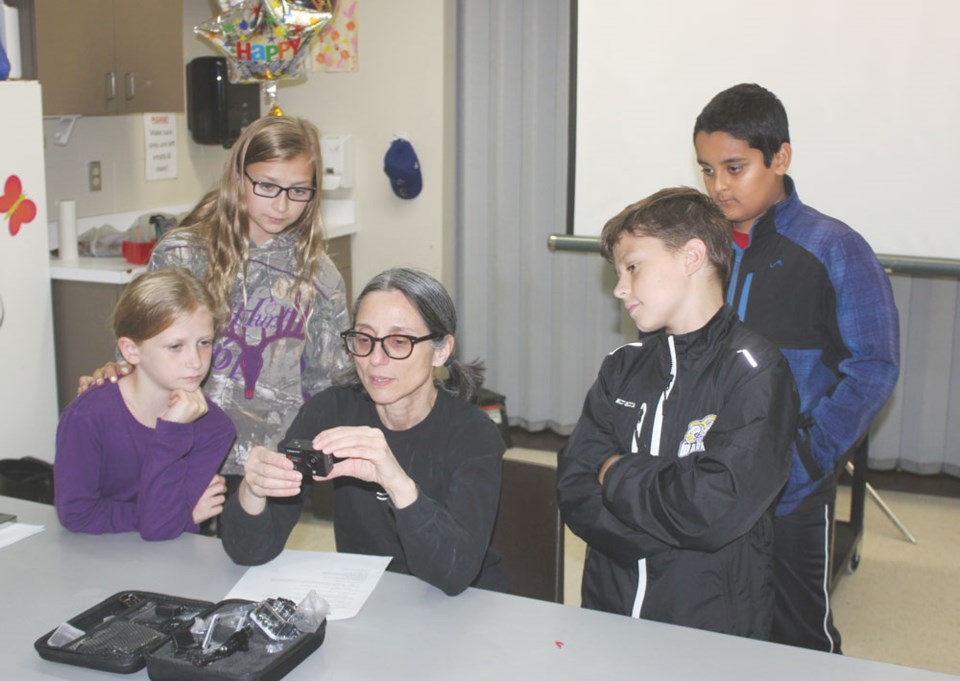Local youths are spending their Saturdays working on a project that brings together their interest in science and their artistic abilities.
The Estevan Public Library has been offering a program that involves balloon mapping for those ages 10 to 13, and constructing air quality sensing rovers for those 13 to 16. Canadian artist Maria Michails, who is working on her PhD in electronic arts at the Rensselaer Polytechnic Institute near Albany, N.Y., is leading the project. She is working in Estevan as part of her PhD studies.
“They based on do it yourself citizen science,” said Michails.
As part of the balloon mapping program, the children are using a kit developed by the Public Lab website to mount a camera, similar to a GoPro, onto giant helium filled balloons.
Once the cameras have been attached to the balloons, and they have been deployed, they will take pictures from 1,000 feet in the air.
“Google Maps has this,” said Michails. “So why do this? Because Google Maps has a set time and a set place when they take these photographs. This gives us a current image of the area.”
The photos will then be stitched together to give an aerial map of Estevan.
Michails said this concept was developed during the BP oil spill. Thanks to a media blackout, local people didn’t know where the spilled oil was heading, so the balloon maps were developed to let people know how close the oil was to the shore.
“You can buy these kits now,” said Michails. “It’s fun. It’s a great way to do mapping. What we hope to do is just take a bunch of photos, and then we’re going to stitch them together, and with the older group that’s going to be working on the second workshop, we’re going to combine these forces and then map the data with the rovers the teenagers will be building.”
The air quality sensing rover program involves children building rovers that can test air quality. The rovers will count dust particles in the air, test gases, and measure temperature and humidity.
“It outputs data from what it’s sensing in the air, so depending on whether it’s a dust sensor or whether it’s a gas sensor. These aren’t meant necessarily to be regulatory sensors. They are there for determining spikes. If there’s something specific in the air, generally you’ll feel it but maybe you won’t smell it.”
The teens will work with Michails to design and write code for their rovers.
Michails said she introduced the teens to an Arduino, which was developed by researchers and technologists in Italy, and explained how it can be used for the rover. Arduinos are very small microchips, and are used by artists and technologists for interactivity in media projects.
“In my case, I’m attaching peripherals such as a little LCD display that just does letters, and two sensors. Because our time is short, I can’t go into the full details of how to use an Arduino, but they’ll certainly get a taste of it.
“And they’ll learn how to program, how to write code, or at least how to read code, and what programming is about.”
It’s not too late for kids to join the program. The remaining sessions will be on Sept. 23, Sept. 30 and Oct. 14. There will be a one-week break for Thanksgiving.
If kids do want to join, Michails said they should do so this week.
“It would be a little bit difficult to go over everything if they come in the third week, when we’re almost ready to deploy,” said Michails.
The enrolments have been capped at eight for each program, and there is still room remaining for both balloon mapping and air quality rovers.
Since Michails is an artist, there is a strong artistic element to the project. Once it is finished, everything will be brought together for an exhibit at the Estevan Art Gallery and Museum in 2019.
That exhibit will also feature an art project that she is tackling in conjunction with the Souris Valley Museum through its Oral Histories of Estevan program, which is also underway. (See story on page 5 for more on that program).
She is also looking for people who are willing to talk to her or be interviewed for their thoughts on the community.
However, it will take some time to complete the library program, the oral histories and the other components, and bring them all together. She’ll come back to the community next year, and then she’ll have to return one more time to piece the show together.
Michails wants to work with communities regarding local environmental issues, while helping kids learn more about the environment in a fun way. She discovered a passion for environmental art while studying for her master’s degree at Arizona State University in 2004.
“When I moved to Arizona, and I learned that there was art and environment, and they could be married, I was in heaven,” said Michails.
She hopes the children registered for the library program gain a greater understanding of their surroundings and environmental issues while learning new skills and thinking expansively about how art, science, technology and community can come together.
“They’re our future,” said Michails. “They’re the ones who are going to be faced with the multitude of overlapping problems, whether it’s economic, environmental or social, they’re going to be faced with a lot of problems.”
And so she hopes they gain the ability to think across disciplines through the program at the library.
There will be the added reward of having their works displayed for the public in a gallery setting.



